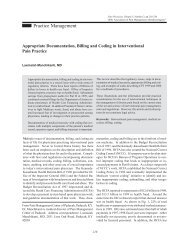ASIPP Practice Guidelines - Pain Physician
ASIPP Practice Guidelines - Pain Physician
ASIPP Practice Guidelines - Pain Physician
Create successful ePaper yourself
Turn your PDF publications into a flip-book with our unique Google optimized e-Paper software.
Manchikanti et al • <strong>ASIPP</strong> <strong>Practice</strong> <strong>Guidelines</strong><br />
28<br />
influences. <strong>Practice</strong> guidelines are systematically developed<br />
statements to assist practitioner and patient decisions<br />
about appropriate health care for specific clinical circumstances.<br />
In contrast, clinical pathways are tools to coordinate<br />
the time-dependent progress of a typical uncomplicated<br />
patient across many clinical departments specific to<br />
the condition or disease being managed (64). The differences<br />
between target patient population ranges from specific<br />
conditions such as acute low back pain, migraine headaches,<br />
sickle-cell disease, and complex pain syndromes,<br />
to much more general guidelines applicable across a variety<br />
of chronic painful conditions. The next issue of controversy<br />
and contention is the definition of evidence. All<br />
of the guidelines incorporate literature review. However,<br />
the categorization of evidence of strength differs across<br />
guidelines. Generally, evidence of strength ranges from<br />
prospective, double-blind, randomized, controlled studies<br />
to uncontrolled case reports. In addition to the evidence,<br />
panels also attempt to use expert consensus, the application<br />
of which varies across the development of the guidelines.<br />
Each panel developing the guidelines feel that their<br />
guidelines applied the most stringent and reasonable evidence.<br />
On the other hand, one group developing the guidelines<br />
tend to criticize another group when they differ philosophically<br />
(3, 7, 21, 24, 25, 27-39, 45, 46, 62, 64-67, 83,<br />
84). In addition, the same evidence may be evaluated by<br />
different groups or authors with variability interpretation<br />
of results. Author bias also exists regardless of the desire<br />
to achieve substantially impartial, scientifically based recommendations.<br />
It is unavoidable that guidelines reflect<br />
authors’ clinical and practice biases, personal philosophy,<br />
and the way the literature is interpreted. Certainly on the<br />
same spectrum, influences of the special interest groups<br />
are inescapable.<br />
CHRONIC PAIN<br />
“We must all die. But that I can save him from<br />
days of torture, that is what I feel as my great and ever<br />
new privilege. <strong>Pain</strong> is a more terrible Lord of mankind<br />
than even death itself.”<br />
- Albert Schweitzer<br />
Schweitzer (85), the great humanitarian, physician, and<br />
Nobel laureate, elegantly described the nature of pain and<br />
the obligation and privilege of the physician and other<br />
health professionals to relieve it in 1931, after nearly two<br />
decades of experience of medical practice in the African<br />
jungle. Approximately four decades later in 1974, John<br />
Bonica, the father of pain medicine, observed: “<strong>Pain</strong> is<br />
the most pressing issue of modern times.” Today, in the<br />
new millennium as then, proper management of pain remains<br />
one of the most important and most pressing issues<br />
of society in general and the scientific community in the<br />
health professions in particular.<br />
Epidemiology<br />
In spite of the best efforts of the public, providers and the<br />
government, pain continues to be an epidemic (86, 87). In<br />
addition, inadequate treatment of pain also continues to be<br />
a public health problem, that is reaching epidemic proportions<br />
in the United States and across the world (86-96).<br />
The knowledge and understanding of this complex entity,<br />
including diagnosis and treatment, are in infancy, in spite<br />
of modern developments in medicine. Providers, patients,<br />
and the government all understand the devastating nature<br />
of chronic pain which destroys the quality of life by eroding<br />
the will to live, disturbing sleep and appetite, creating<br />
fatigue, and impairing recovery from illness or injury (86-<br />
100). In elderly patients it may make the difference between<br />
life and death by resulting in vocational, social, and<br />
family discord (100-105). Pahor et al (102) found that<br />
pain relief is particularly elusive for older women with disabling<br />
back and lower extremity problems. In this study,<br />
approximately two thirds of the women reported significant<br />
levels of pain and difficulty in controlling it. Asch et<br />
al (106) measured underuse of necessary care detecting<br />
substantial underuse problems for various conditions, including<br />
depression, and concluded that these problems<br />
likely result in negative outcomes in the elderly population.<br />
The concept of chronic pain is beset with controversy, starting<br />
with its very definition. For some chronic painful conditions,<br />
it is defined as, “pain that exists beyond an expected<br />
time frame for healing.” For other conditions, it is<br />
recognized that, “healing may never occur.” Bonica defined<br />
chronic pain as, “<strong>Pain</strong> which persists a month beyond<br />
the usual course of an acute disease or a reasonable<br />
time for any injury to heal that is associated with chronic<br />
pathologic processes that causes a continuous pain or pain<br />
at intervals for months or years” (107). In many cases,<br />
chronic pain is understood as persistent pain that is not<br />
amenable to routine pain control methods. In a Gallup<br />
Survey of “pain in America” more than 4 out of 10 adults<br />
(42%) say they experience pain on a daily basis (108).<br />
Americans age 65 and older are more likely to experience<br />
pain for longer periods of time than younger Americans<br />
(108). Andersson et al (109) reported incidence of persistent<br />
pain for 6 months in 49% of the adult population, with<br />
functional disability in 13%. Perquin et al (97) reported<br />
<strong>Pain</strong> <strong>Physician</strong> Vol. 4, No. 1, 2001
















